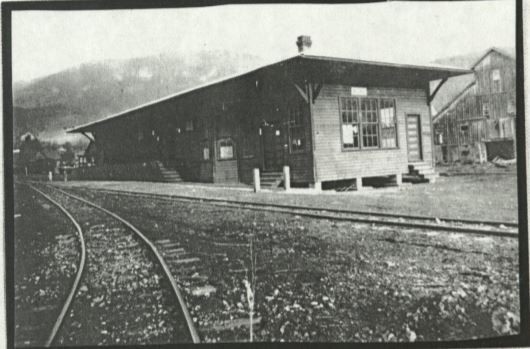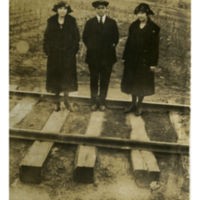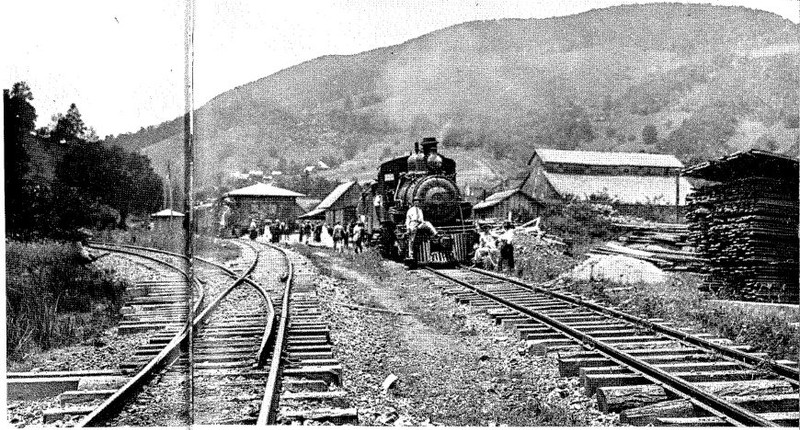Tweetsie Railroad Depot/Cafe Portofino
Introduction
Text-to-speech Audio
Images
From 1917 to 1940, this building housed the maintenance station for Tweetsie Railroad.

Undated Photograph of Students Standing on Railroad Tracks in Boone, NC

Undated Photograph of the Railroad and Railway Depot in Boone, NC

Backstory and Context
Text-to-speech Audio
Boone was once small and isolated as a part of the western North Carolina region known as the lost provinces (Ashe, Allegheny, and Watauga counties).1 In 1917, Boone’s reputation as a lost province permanently changed when the East Tennessee and Western North Carolina Railroad laid tracks into Boone for a narrow gauge railroad which became affectionately known as the “Tweetsie” railroad.2 The president of Appalachian Training School, Dr. Blanford Barnard Dougherty, and the editor of the Watauga Democrat, Rob Rivers, both assisted with bringing the railroad to Boone.3 The railroad served economic goals as it brought the logging industry to the area and allowed Boone to expand its cabbage and potato industries by opening up new markets.4 For the first time, Boone was easily accessible for both mail and passengers as it became connected to its closest trading center: Johnson City, TN.5 This connected Boone to the Southern Railway and thus the entire eastern region of the United States.6
The whistle of “Tweetsie,” the locals’ affectionate name for the train, now echoed through the high country.7 Though tax records suggest this building was not a taxable property until 1930, from 1917 to 1940, this site served as the original Tweetsie Depot.8 The railroad was immensely popular and ran daily except for Sundays. Like many other railroads in mountainous regions, the railroad’s popularity began to wane with the depletion of lumber in the area. It was not until after flooding from a hurricane destroyed some of the tracks that the depot finally closed its doors in 1940 after Tweetsie’s final run on Tuesday, August 12, 1940.9 Trains never frequented Boone again.10
Though trains never frequented Boone again, they were to remain a permanent fixture in the area. Tweetsie Locomotives no. 12 and no. 190 were sold to the White Pass and Yukon Railroad in Alaska, and Hollywood’s Gene Autry expressed interest in using them for films.11 Before Gene Autry could purchase the locomotives, locomotives no. 12 and no. 190 were purchased in 1956 by the Robbins family for the Tweetsie attraction in Blowing Rock, NC.12 Thus, the railroad industry might have been gone, but it left behind a legacy in the region. Though most people seek this legacy out at the Tweetsie Railroad in Blowing Rock, it also lives on at the Portofino’s building in Boone: the first and last place Tweetsie (and the railroad) stopped in Boone.
The depot once served to place Boone in the larger context of the world. It was a place that served to open the doors for communication, industry, and travel between Boone and the rest of the world. In the community’s repurposing of the building as a restaurant, it still serves as a place of connection. Except, instead of connecting the people of Boone with the world, it serves as a place where Boone builds community as people socialize over drinks and a meal.
Sources
1. “After 65 Years, First Railroad Built,” Watauga Democrat, July 1, 1976, AC.493: Herman Wilcox Collection, W.L. Eury Appalachian Collection, Appalachian State University, Boone, North Carolina, USA.
2. “Extend Tracks Back to Boone, NC,” Tweetsie Railroad, accessed October 4, 2016, https://tweetsie.com/explore-the-park/timeline/#event-extend-tracks-to-boone-nc.
3. Old Railway Station - Boone, Undated Narrative History, AC.112: Watauga County Historical Site Survey Records, W. L. Eury Appalachian Collection, Appalachian State University, Boone, North Carolina, USA; Mallory Hope Ferrell, Tweetsie Country, (Johnson City, TN: The Overmountain Press, 1979), 31.
4. Mallory Hope Ferrell, Tweetsie Country, 31.
5. Old Railway Station - Boone.
6. Mallory Hope Ferrell, Tweetsie Country, 31.
7. Ibid., 86.
8. Watauga County Tax Administration, Property Records, 970 Rivers Street, PARID 2900787965000, accessed November 21, 2016, http://tax.watgov.org/WataugaNC/Datalets/PrintDatalet.aspx?pin=2900787965000&gsp=SUMMARY&taxyear=2016&jur=095&ownseq=0&card=1&roll=REAL&State=1&item=1&items=-1&all=undefined&ranks=Datalet; “Welcome,” Café Portofino, accessed October 4, 2016, http://cafeportofino.net/home.php.
9. “Torrential Rains and Severe Flooding,” Tweetsie Railroad, accessed October 4, 2016, https://tweetsie.com/explore-the-park/timeline/#event-torrential-rains-and-severe-flooding.
10. Ibid.
11. “Tweetsie got out in time,” Watauga Democrat, Flood Edition, AC.493: Herman Wilcox Collection, W.L. Eury Appalachian Collection, Appalachian State University, Boone, North Carolina, USA.
12. Ibid.
Image One Photo Credit: Old Railway Depot, undated, Old Railway Depot Image, AC.493: Herman Wilcox Collection, W.L. Eury Appalachian Collection, Appalachian State University, Boone, North Carolina, USA.
